“Nothing draws a crowd quite like a crowd.” – P.T Barnum.
This statement still holds true. When existing customers recommend a product to their friends, family, and colleagues, people listen— a.k.a word-of-mouth. That’s why, it’s important to constantly understand the pulse of your customers.
You need to identify your most loyal users who can become your product advocates and spread the word about your business.
Now the question is: What is the best way to gauge customer loyalty? The answer is simple: Net Promoter Score (NPS). In fact, it is the gold standard for customer loyalty metrics globally.
In this article, we will explain everything about NPS so you are better prepared to run this survey at your organization.
What is Net Promoter Score (NPS)? How is it calculated?
Ever since its inception in 2003 by Bain and Company, NPS has been considered a yardstick in customer experience evaluation. Its rise in popularity is such that, today, if you need to measure customer loyalty and enthusiasm for a brand, it is the de facto choice for measurer.
A survey states that nearly two-thirds of the Fortune 1000 companies use NPS as a customer success metric because of its simplicity and easy implementation.
To conduct an NPS survey, you just have to ask one simple question to your existing customers:
|
On a scale of 0-10, how likely are you to recommend our <services/ products/company> to a colleague, family or friend? *Where 0 is considered not likely at all, and 10 is considered highly likely to recommend. |
Resist the urge to tamper with the core NPS question used. Straying from this dilutes the power of NPS and complicates comparisons.
Based on how your customers rate you, they are grouped into three different buckets:
- Detractors: Users giving a score between 0-6
- Passives: Users giving a score of 7 or 8
- Promoters: Users answering with a score of 9 or 10

Now, all you have to do is identify the percentage of promoters and subtract it from the percentage of detractors. This will give you your company’s NPS score, which you can then compare with market benchmarks and competitors to understand how well you are performing.
Use the formula to calculate Net Promoter Score: NPS = % of Promoters ( — ) % of Detractors
For example, if your NPS survey marks 65% of responders as promoters and 55% as detractors, the NPS score will be 10.Theoretically, NPS can range anywhere from -100 to 100, where -100 indicates no promoter for the brand, and 100 indicates no unhappy customers. Even though achieving such extremes is unlikely, you definitely want a positive NPS score. Ideally, you should keep track of the NPS regularly and aim to improve it over time.
You might be wondering, with so many high-tech solutions and advanced algorithms to predict customer behavior available in the market, is using one simple question to understand customer loyalty still relevant? We’ll tell you.
Is the NPS still relevant?
Long story short, yes, it is still relevant. NPS is a great tool to measure the word of mouth potential – helping you identify loyal promoters and potential churners. However, it doesn’t tell you the whole story.
NPS focuses on the “who”— who is enthusiastic enough to recommend you. But it doesn’t look deeper into the “why”— why is someone satisfied or dissatisfied?
For example, a customer might be lukewarmly satisfied but wouldn’t rave about your product to others or abandon you completely. NPS wouldn’t help capture this nuance.
To understand the “why,” you need to have a holistic view of the customer’s journey and interaction. This means tracking your customer acquisition, engagement, and retention with metrics like product usage, referral rate, CAC, Daily and monthly active users, etc. Relying solely on NPS can lead to a distorted view. By tracking the additional metrics, you can pinpoint areas for improvement and avoid the pitfalls of a one-metric approach.
We recommend using technology solutions that provide a complete picture of customer journeys and granular analysis of product usage, along with NPS surveys to better serve your customers.
Why is Net Promoter Score important?
Now that we’ve discussed what NPS is, here are some key reasons why it is important to use NPS as a means to measure the customer perception of your brand:
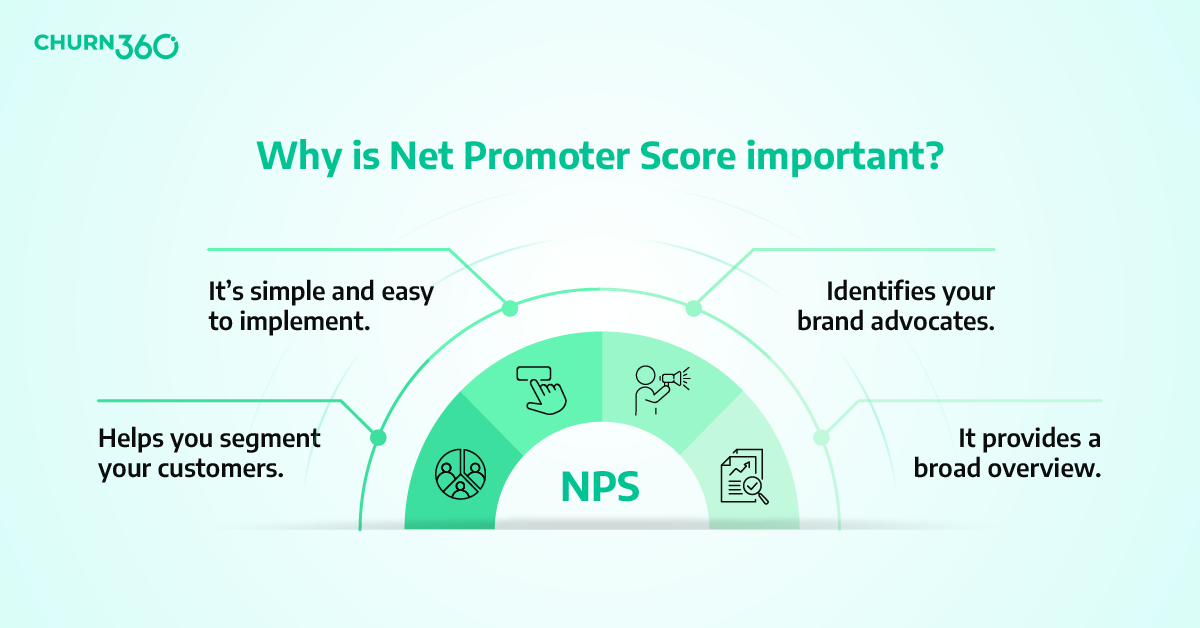
It’s simple and easy to implement
From the viewpoint of the customer, there’s nothing easier than the simple one-question survey that makes up the NPS. Customers are much more likely to complete short surveys that don’t take up too much of their valuable time. Studies suggest that shorter surveys have better response rates. With shorter surveys, they don’t have to think too hard to answer your one question— They just rate your business on a scale of 0 to 10.
Read more: Best Practices for Net Promoter Score Implementation
Helps you segment your customers
The next advantage of the NPS survey is that your customers are segmented into three groups: Detractors (score 0-6), Passives (score 7-8), and Promoters ( score 9-10). You can use this segmentation to predict future behavior and take actions based on their score.
For example, if someone is a detractor, you can follow up with them to find out why they gave such a low score and potentially fix the problem.
Identifies your brand advocates
When someone gives you a good NPS rating, they are happy with your product and are willing to recommend it to others. You can use this as an opportunity to ask them for referrals and online reviews.
Here is how identifying and nurturing promoters can help your organization:
- Promoters are loyal customers who spend more over time. By exceeding their expectations and fostering loyalty, you can significantly increase customer lifetime value for your company.
- Promoters are natural salespeople. Their word of mouth can organically bring you new customers, lowering your CAC and reducing your reliance on paid advertising.
It provides a broad overview
Surveys, like CSAT or CES, only measure a customer’s last interaction with your brand and how they feel about a particular experience. In contrast to NPS, they don’t look at the customer’s entire relationship and can only provide short-term data that might not reflect the true picture of the customer’s perception of your brand. NPS captures your customer’s feelings towards your business in its entirety.
Best practices for implementing and utilizing NPS effectively
Here are some NPS best practices you should keep in mind:
Make sure you use a robust NPS survey tool that helps you collect the survey and analyze the data to present an accurate picture of customer sentiment – the overall feeling and opinion your customers have towards your brand. Additionally, using tools for conducting NPS helps you,- Identify the right time to trigger the survey (both in-app and over email) to get the maximum responses.
- Understand the reason behind the response so that your CS team can engage and provide the best support.
- Combined with customer journey and Health Score, it helps you better understand customer needs and deliver proactive support.
- Provide accurate customer segmentation so that you can plan your retention strategies accordingly. You can clearly segment your customers into promoters (loyal advocates), detractors (unhappy customers) and passives (neutrals).
Get buy-in from key decision-makers within the company for best results with NPS. It is also important that the teams directly communicating with customers (CS teams) understand the importance of NPS surveys. Based on the survey responses, they can further personalize customer interactions.
Types of NPS Survey: Transactional Vs Relational NPS Programs
A relational NPS survey is typically sent after a fixed time, such as quarterly or annually. The aim here is to keep checking what your customers think about the brand on a regular basis. This data is used to check how effective your customer retention strategies are and whether your customer will churn in the future.
For example, SaaS companies can send a relational NPS survey to their customer base every quarter to understand overall customer satisfaction for the quarter.
A transactional NPS survey, on the other hand, is sent out after every customer interaction with your brand. It could be after a purchase or a support call. The goal of a transactional NPS survey is to understand how that individual interaction went.
For example, if you are running an e-commerce store, you can share an NPS survey after a customer completes a purchase. This will help you understand their satisfaction with the purchasing experience on your site.
While a transactional NPS survey might seem like you are trying to understand the customer experience at a granular level, it is not advisable to send the survey on every interaction. Identify the most important customer touch points and send the surveys during those times only to reduce survey fatigue.
How to conduct an NPS survey using Churn360?
Here are 5 simple steps to conduct a successful NPS survey for your brand using Churn360’s NPS survey tool:
Step 1: Determine the delivery mode
The first step is to determine how you will distribute the survey. The distribution method, whether through email or in-app, should align with your brand’s audience and goals. Churn360 supports both these channels, so you can determine what works best for your business. While email is less intrusive, in-app is known for its ease of eliciting responses from survey takers.
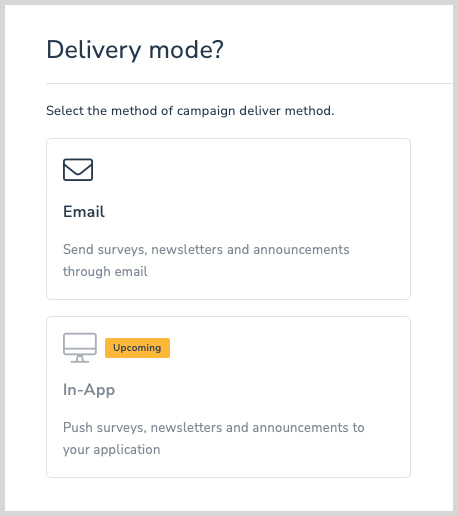
Remember, timing is everything with NPS. Asking right after the first use or the purchase captures fleeting emotions that may not translate to long-term loyalty. On the other hand, asking too late can result in details being forgotten. Find the sweet spot— ideally, after they have had a chance to truly experience the value of your product/service.
Step 2: Draft NPS survey questions
Next, frame your core NPS survey questions. Ideally, the primary question should revolve around the statement – “On a scale of 0-10, how likely are you to recommend our <services/ products/company> to a colleague, family or friend?”. You can use this statement as it is or use one of its variants.
Apart from this, as a best practice, you can also add demographic and additional open-ended questions to understand the reasons behind customers’ ratings. Churn360 even lets you add separate questions for promoters, passives, and detractors so that the experience is personalized.
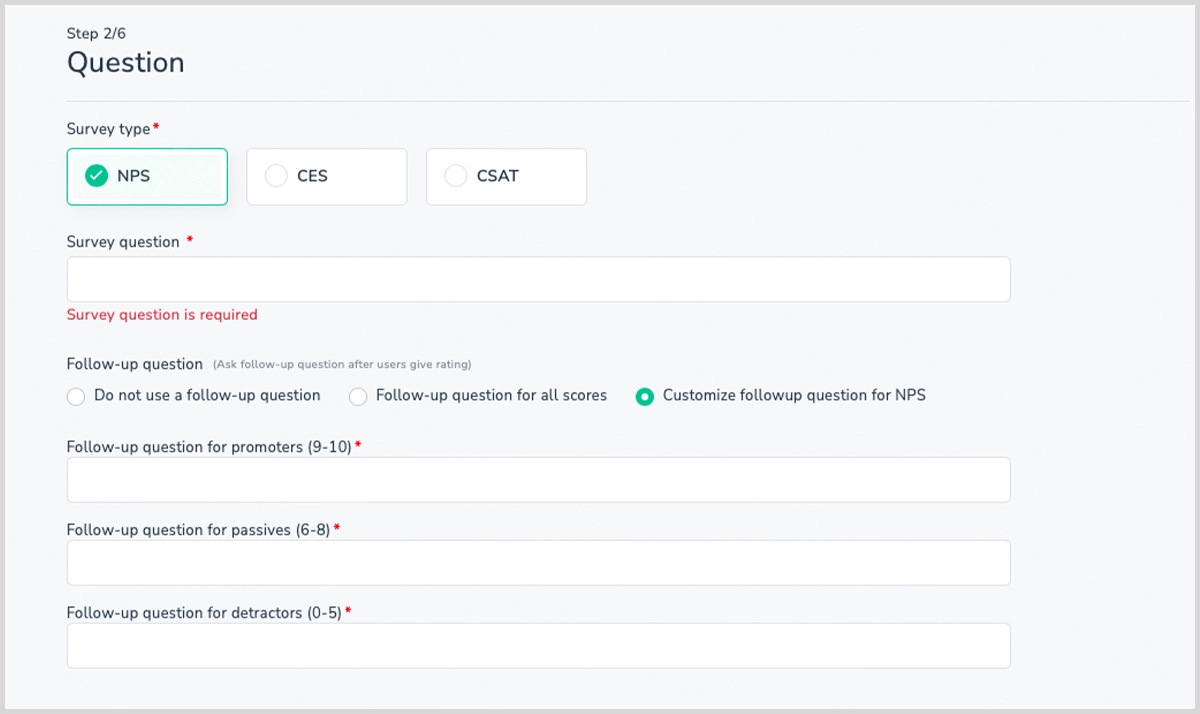
When you combine all these three categories of questions, you construct a comprehensive survey instrument that not only captures quantitative data but also provides qualitative insights into the customer experience.
Step 3: Choose the audience
Different segments of your customers might have varying experiences and expectations. This will have a direct impact on their likelihood of recommending your brand. By selecting the right segments, such as long-term customers, enterprise clients, or users of specific products or services, you can gather targeted feedback. This will provide deeper insights into satisfaction levels and loyalty drivers.
In a nutshell, by selecting the audience beforehand, you enhance the relevance and reliability of your NPS data. It also paves the way for more effective action planning and decision-making.
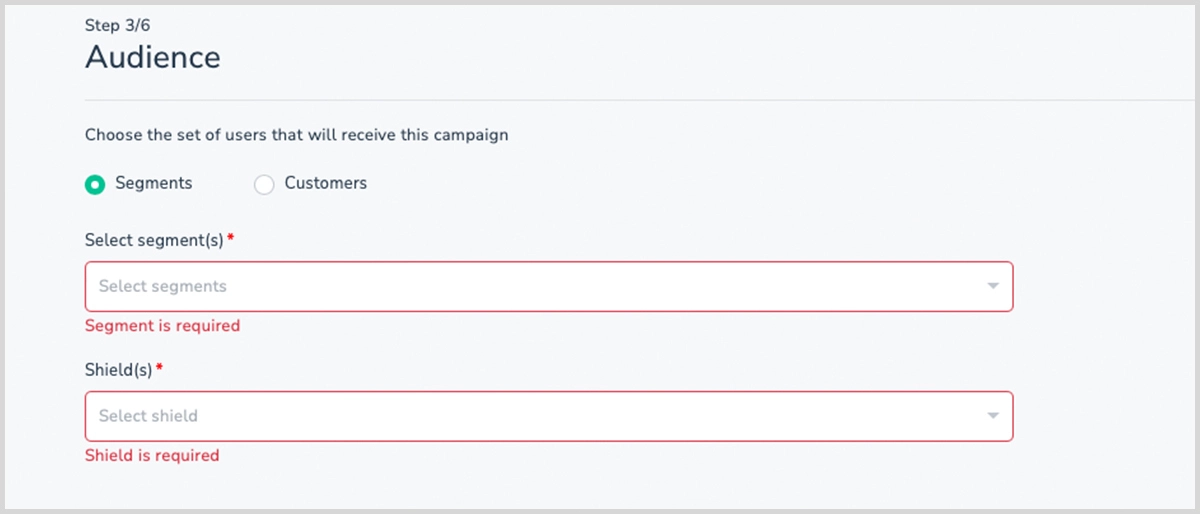
Step 4: Design the survey
A carefully crafted NPS survey captures respondents’ attention and encourages them to engage with the survey. A neat layout and well-designed forms make the experience enjoyable for the customers and improve the chances of getting responses.
Churn360 offers a customizable and ready-to-use NPS survey template that can be tailored to your needs. For instance, you can add/remove columns, images, buttons, dividers, and so much more. You can even change the text color and font to make it suitable for your audience.
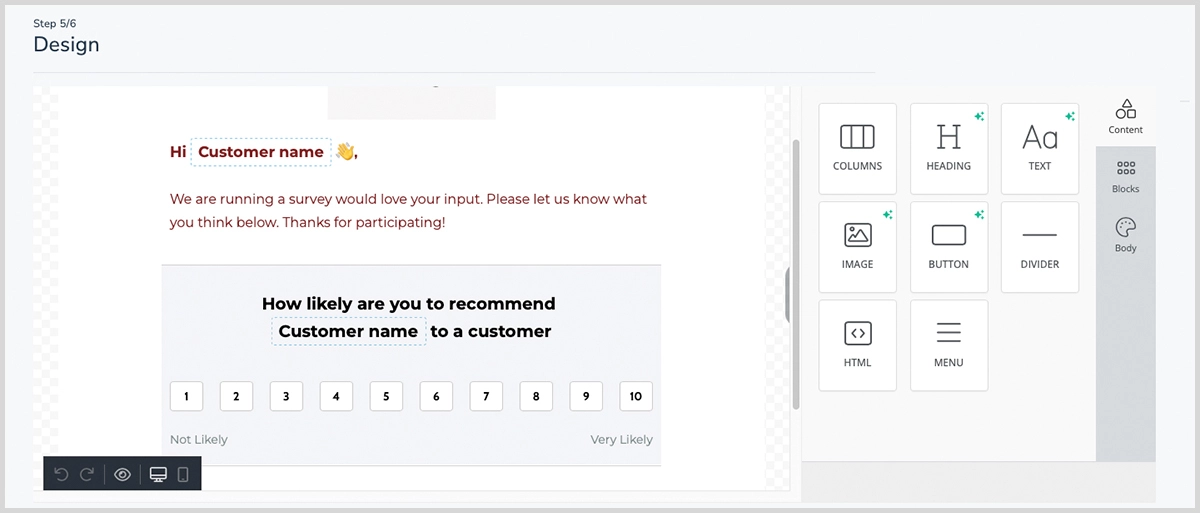
Step 5: Take action to turn Detractors into Promoters
The final step involves translating NPS findings into actionable steps. Develop a detailed action plan to address the detractors’ concerns. Acknowledge their feedback through an email or a phone call, demonstrating a willingness to understand their perspective and resolve issues. Remember not to get defensive during these conversations— Taking proactive measures to turn detractors into promoters involves continuous improvement and incorporating customer feedback into the company’s processes and strategies.
Additionally, make sure you reach out to detractors who haven’t specified the reasons for their low scores as well. The idea is to identify any potential improvement opportunities and address their concerns.
NPS surveys should not be viewed as one-time assessments but rather as part of an ongoing cycle of improvement and customer engagement. By consistently iterating on the feedback received, you can foster long-term customer satisfaction and loyalty.

How do you interpret your NPS survey results?
Most people think that NPS is simply an indicator, a metric to track customer experience. But it is much more than that. It deals with a variety of touchpoints and channels in every stage of the customer lifecycle, from awareness to post-purchase interactions. In fact, it is a key component of your ongoing improvement process. Whenever you run an NPS survey, you are measuring your current performance with your past performance and finding out how you can improve yourself for the future.
However, you cannot just rely on NPS because it is a signal to show what your customers think about your product or service and does not tell anything about the reasons. To understand ‘the why,’ you need to collect data from other sources about customer experience. For instance, you could use a dedicated customer experience management software that can analyze interactions across different channels and pinpoint trends and deviations.
What types of questions should we cover in the NPS survey?
While many believe that an NPS survey is predominantly a single-question survey, it need not always be. You can support it with a set of additional questions to make your survey easier to analyze and take appropriate action. Apart from the basic NPS-specific questions, you can ask additional questions that will aid in the segmentation process of survey takers later during the analysis. The questions could be related to company size, respondents’ designation and role in the organization, or product usage frequency.
You could also include some open-ended questions that encourage detailed and qualitative feedback. A sample question could be – “Can you please elaborate on what influenced your score and any specific experiences you’d like to highlight?”
Using NPS as an input for customer churn prediction model
As covered previously, using NPS alone gives you an incomplete picture of customer behavior. But when you blend the customer experience metrics like NPS and CSAT with the Customer Churn data, you can:
- Identify at-risk customer segments and predict churn
- Understand the reasons behind customer’s sentiment
- Plan targeted interventions to reduce churn
- Increase the customer lifetime value
Traditionally, creating this type of customer churn model in-house is a labour-intensive process and requires the assistance of tech experts and skilled statisticians. Not only do you have to consider the best model combination that understands the nuances of your business, but you also have to train it with historical data similar to your audience size and type. If the data is not of high quality or sufficient quantity, there is a high chance the churn model will not perform accurately, giving you a skewed churn prediction. Moreover, you constantly have to feed the model with real-time, accurate customer data.
However, with a customer success platform like Churn 360, you can streamline the process. It automatically connects customer experience data with operation data from various sources like CRM, Support channels (Email and Chat), Product usage, and Data streaming to accurately identify who is at risk of churn and its potential reason.
To know more about Churn360 and how it can help your brand, BOOK A FREE DEMO now.
FAQs about Net Promoter Square
1) Can the NPS score be considered as a Key Performance Indicator?
Yes, absolutely. NPS is a common KPI used extensively to measure customer satisfaction and loyalty. It helps you understand how likely your customers are to recommend your brand to their friends and colleagues. This can help guide your business decisions and improve customer success efforts. For example, you can identify promoters (scores 9-10) who are very happy with your product and approach them for cross-selling and up-selling opportunities. Likewise, understanding the reasons behind the NPS score can also help you refine your marketing and sales messaging.
2) Is a Net Promoter Score a good method to evaluate product market fit?
Yes, while building a product, you can use the NPS survey to gauge customer sentiment toward your brand and identify promoters. If you have a large number of promoters, you can even ask them for referrals.
Likewise, when building a new product feature, you can analyze the NPS score along with comments of detractors (score 0-6) to better understand what is causing customer dissatisfaction and pin-point areas of product improvement.
However, the NPS metric should not be used alone as it does not provide a complete picture, instead, combine it with other metrics like Churn rate, CAC, and sales growth to understand how your business health indices are looking.
3) Can a company have a higher Net Promoter Score (NPS) even if its overall sales or revenue are declining?
Yes, it’s definitely possible for a company’s NPS to increase despite a decrease in revenue. While these metrics are ideally connected, there can be temporary situations where they move in opposite directions. For example, businesses might see a boost in NPS and a drop in revenue margins when they are running discounts and promotions. Likewise, if the economic conditions are bad or there is a change in customer base, businesses might see a drop in revenue despite seeing a hike in customer base.
4) How should I share the NPS survey with my customers, by email or via push notifications?
You can use any method to obtain the NPS survey responses. Ideally, you want to obtain statistically relevant data, and for that, you need to collect as much data as possible. We suggest conducting a simple A/B test to understand where you are getting maximum responses from and then using that particular platform for the larger customer base. For example, during your pilot experiment, if the in-app customer response rate is higher than the NPS survey conducted via email; It makes sense to collect surveys in the App.
5) How many customers should I target at a time for the NPS survey, and how often should I conduct it?
There is no right answer to this question. As long as the number is statistically significant and you can generate insights from the survey results, you are good. But, ideally speaking, the higher the number of customers, the more accurate the results will be. You can conduct the survey once every quarter for optimal results.
6) I am not getting enough responses on NPS surveys, how can I improve my NPS survey response rates?
There is no shortcut to running a successful NPS survey. You need to first run a pilot survey with a small group of audience. Test different kinds of questions and see what works and what doesn’t. Do a thorough analysis and come up with a solid strategy. Finally, implement the strategy and check the results. Repeat the process if required.
7) Should I have a follow-up plan after the NPS survey?
Yes, mainly because NPS gives you only half the picture. In other words, it tells you who is unhappy with your brand but not why. To get a better understanding of this, you need to support the NPS survey with additional surveys. For instance, you can use the 360-degree customer view and the Health Score features of Churn360 to understand your customers at a granular level and serve them better.


